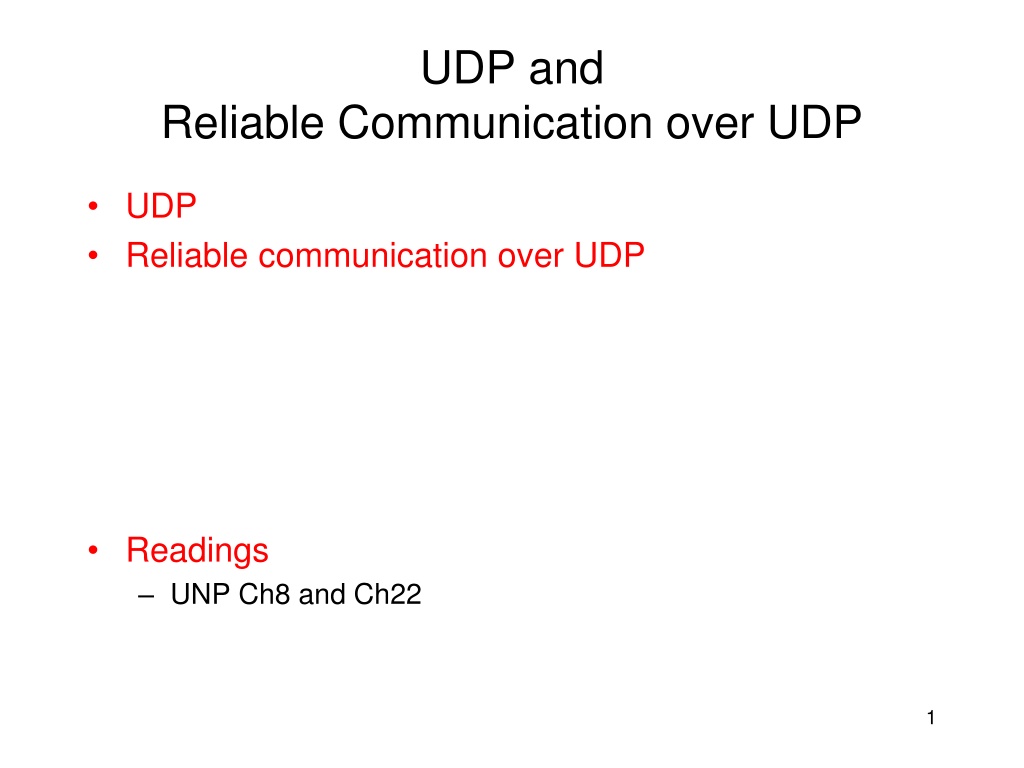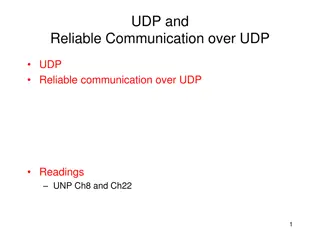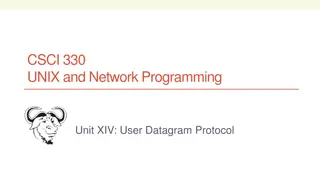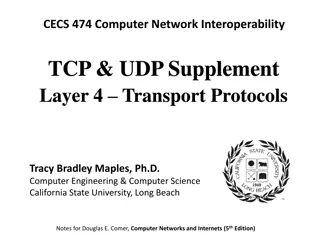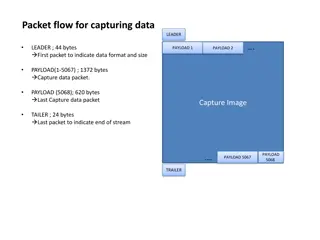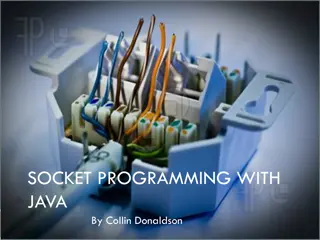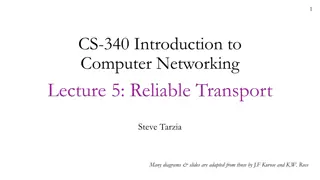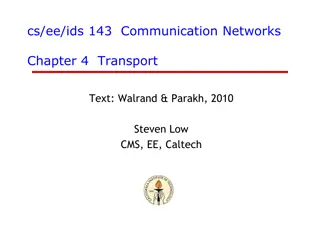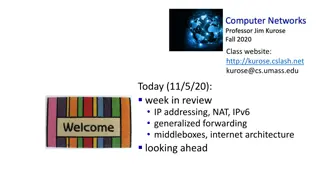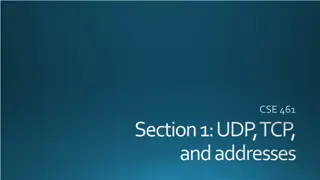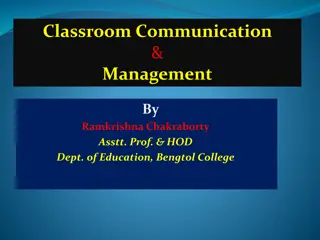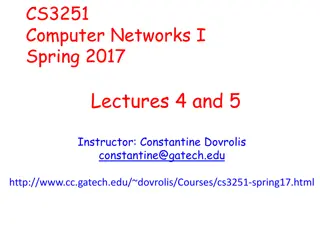Understanding UDP and Reliable Communication
Explore the differences between UDP and TCP protocols, the need for UDP in certain applications, the basic UDP Socket API, and the concept of adding reliability to UDP communication through flow control and error management techniques.
Download Presentation

Please find below an Image/Link to download the presentation.
The content on the website is provided AS IS for your information and personal use only. It may not be sold, licensed, or shared on other websites without obtaining consent from the author. Download presentation by click this link. If you encounter any issues during the download, it is possible that the publisher has removed the file from their server.
E N D
Presentation Transcript
UDP and Reliable Communication over UDP UDP Reliable communication over UDP Readings UNP Ch8 and Ch22 1
TCP vs. UDP TCP: Reliable byte stream service. Different ways to build clients and servers Some problems when building clients/servers with TCP How to get around blocking I/O Data format conversion Basic assumption: whatever sent will eventually be received!! UDP: Unreliable datagram service. Data may get lost application may need to deal with more details in the communication. 2
Why UDP? Applications that do not need 100% reliability communication. E.g VoIP, video stream, DNS servers. Applications care a lot about performance: high performance computing (TCP cares too much about other things than performance). Applications that need multicast or broadcast (TCP only supports point to point communication). 3
UDP Socket API Basic UDP service interface: socket, bind, sendto, recvfrom, close TCP server TCP client UDP server UDP client socket socket bind connect listen accept read/write close Read/write close socket socket bind sendto recvfrom recvfrom sendto close 4
UDP Socket API TCP and UDP ports are independent Communication using UDP See udp1.c and udp2.c Show loss of packets in UDP example program? Why? #include <sys/socket.h> ssize_t recvfrom(int sockfd, void *buff, size_t nbytes, int flags, struct sockaddr *from, socklen_t *addrlen); ssize_t sendto(int sockfd, void *buff, size_t nbytes, int flags, const struct sockaddr *to, socklen_t addrlen); 5
Reliable Communication over UDP Two types of errors: transmission error and buffer overflow. Transmission errors are due to physical errors. Such an error has to be dealt with by an error control mechanism. Buffer overflow occurs when the sender sends faster than the receiver can process the packet. This happens a lot since the OS and applications are usually not real time. Solution: slow down the sender Technique to deal with this problem is usually called flow control. Make UDP reliable = adding flow control and error control to UDP. 6
Starting point: do nothing program Sender (example1.c) Receiver (example2.c) For (I=0; I<NUM; I++) Sendto ( ) While (1) Recvfrom( ) 7
How to Do Flow Control Control the speed of the sender if the receiver does not have enough buffer, stop sending. How to do it? How to slow the sender (example1.c) down in? Adding delay (sleep??) Performing handshaking the only reliable way to slow down the sender. 8
P1: Stop and wait (flow control) Sender (example1.1.c) For (I=0; I<NUM; I++) Sendto( ) Wait for ACK (recvfrom) Receiver (example2.1.c) While (1) Recvfrom( ) Send ACK (sendto) 9
Packet Loss Example1.1.c and example2.1.c resolve the flow control problem. What would happen if some packet gets lost? Solution. Add timeout to the sender If a packet gets lost, the sender should timeout and resend the packet. How to implement a timeout mechanism? 10
P2: Stop and wait + timeout Sender (example1.2.c) For (I=0; I<NUM; I++) Sendto( ) Wait for socket to read for a timeout time (select) If (timeout) { Resend (sendto( )) Go to wait Else receive ACK (recvfrom) Receiver (example2.2.c) While (1) Recvfrom( ) Send ACK (sendto) 11
Packet Duplication Any problems with example1.2.c and example2.2.c? Some packets get duplicated!! How to resolve this problem? The receiver must be able to recognize whether it has received a RIGHT packet should throw away the duplicated packets!! How to do this? Add an identifier to each packet sent sequence number. The receiver should record what it receives. 12
P3: Stop and wait + timeout+ sequence num Sender (example1.3.c) For (I=0; I<NUM; I++) Seq = I; Sendto( seq ) Wait for socket to read for a timeout time (select) If (timeout) { Resend (sendto( )) Go to wait Else receive ACK (recvfrom) Receiver (example2.3.c) Exp = 0; While (1) Recvfrom( ) If (seq != exp) throw it away send ACK; Else // correct packet processing the packet exp ++; send ACK 13
Efficiency The protocol implemented in example1.3.c and example2.3.c is called Positive Acknowledgement with Retransmission (PAR) protocol. A reliable transmission protocol But not the most efficient The network (and end hosts) is idle sometimes Sliding window protocols improve the performance of PAR 14
